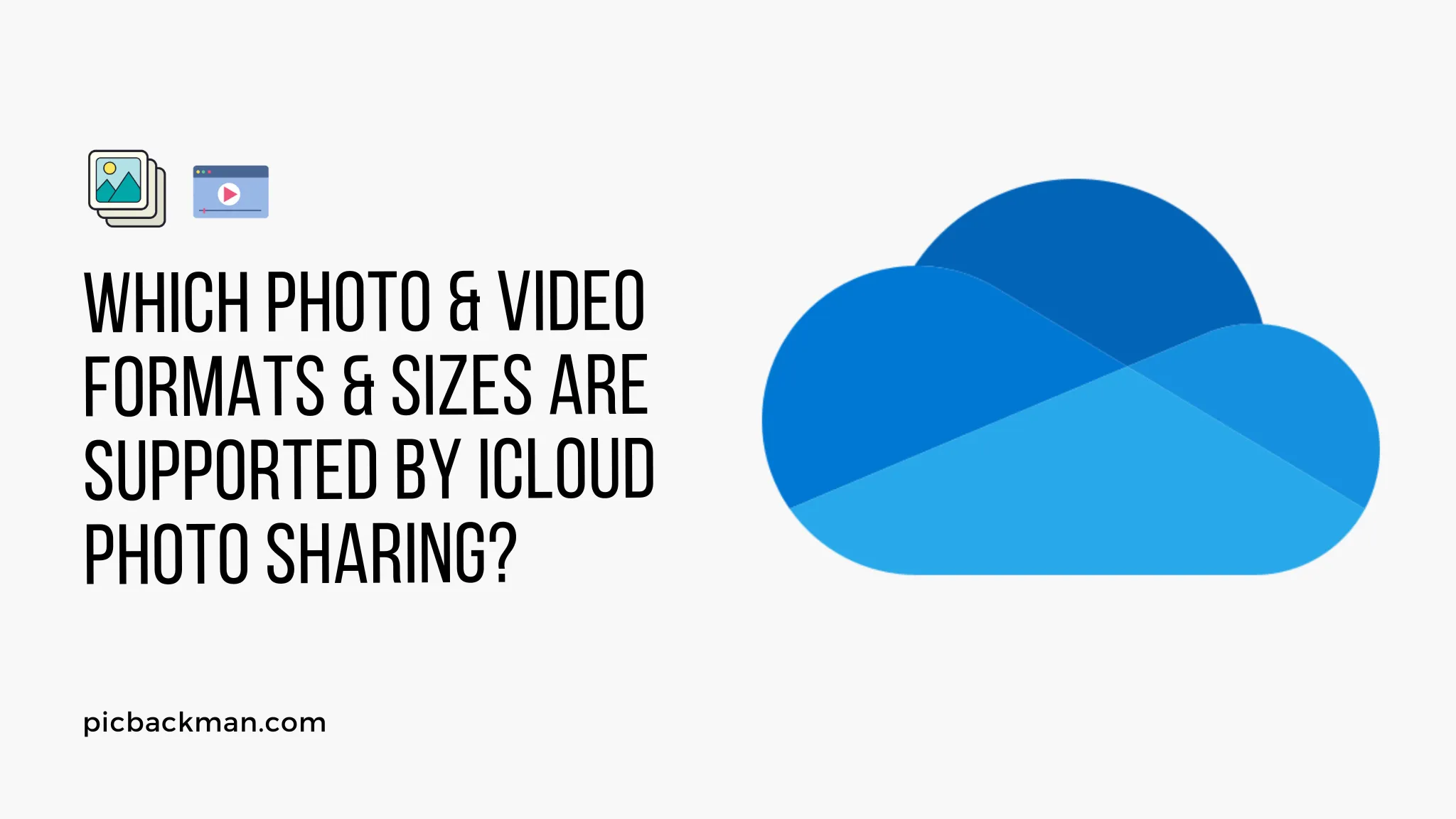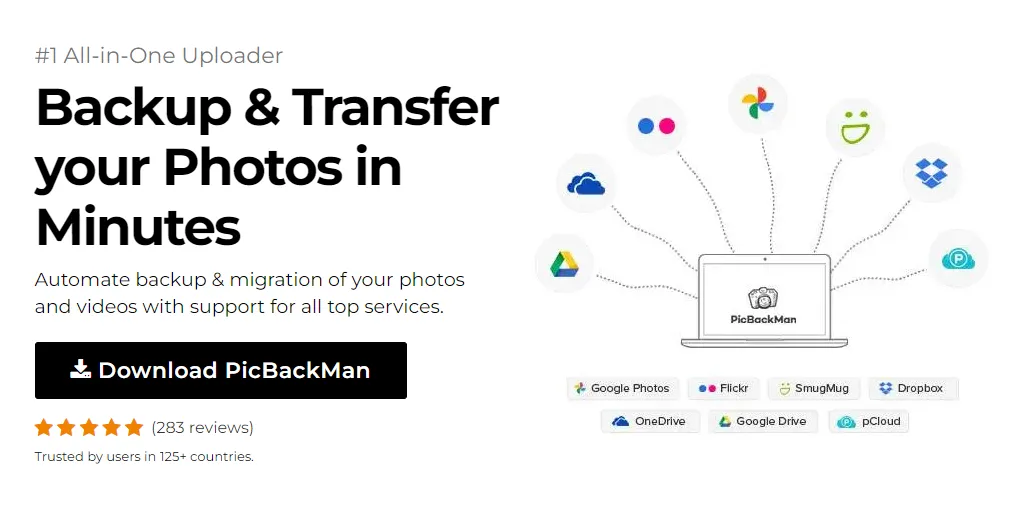
Why is it the #1 bulk uploader?
- Insanely fast!
- Maintains folder structure.
- 100% automated upload.
- Supports RAW files.
- Privacy default.
How can you get started?
Download PicBackMan and start free, then upgrade to annual or lifetime plan as per your needs. Join 100,000+ users who trust PicBackMan for keeping their precious memories safe in multiple online accounts.
“Your pictures are scattered. PicBackMan helps you bring order to your digital memories.”
Which photo & video formats & sizes are supported by iCloud Photo Sharing?


In this digital age, our photo and video collections have become larger and more diverse than ever before. With the advent of cloud storage solutions, such as iCloud Photo Sharing, managing and sharing these media files has become significantly more convenient.
However, to make the most of this feature, it's crucial to understand the supported photo and video formats and sizes for iCloud Photo Sharing. This article will guide you through the various formats and sizes that iCloud Photo Sharing can handle, ensuring that your cherished memories remain accessible and shareable across Apple devices and beyond.
With the proliferation of smartphones and digital cameras, we capture countless photos and videos that hold significant memories and moments. Storing these media files on our devices might eventually lead to storage issues. iCloud Photo Sharing, a service provided by Apple, offers a seamless solution for storing, organizing, and sharing these precious moments across all Apple devices.
Supported Photo Formats
iCloud Photo Sharing supports various photo formats, including:
JPEG
JPEG is the most widely used and compatible format for photos. It ensures excellent image quality while maintaining a reasonable file size.
PNG
PNG is ideal for images that require a transparent background. However, PNG files are larger compared to JPEG.
GIF
GIFs are a popular choice for sharing short animated images. iCloud Photo Sharing preserves the animation in GIFs.
TIFF
TIFF files are known for their lossless compression, making them suitable for professional photographers and graphic designers.
Supported Video Formats
iCloud Photo Sharing also accommodates a range of video formats, such as:
H.264
H.264 is a widely supported video codec that offers an excellent balance between video quality and file size.
HEVC
HEVC (High-Efficiency Video Coding) is a newer video codec, providing superior compression for high-quality videos.
MPEG-4
MPEG-4 is a versatile video format compatible with various devices and platforms.
Recommended Photo Sizes
When uploading photos to iCloud Photo Sharing, consider the following size options:
Small
Ideal for quick sharing and conserving storage space. Recommended for online sharing and messaging.
Medium
A compromise between size and quality, suitable for most sharing purposes.
Large
Preserves higher resolution for better viewing on larger screens.
Actual Size
Upload the original photo resolution without compression.
Recommended Video Sizes
For videos, consider the following size options:
Low-Resolution
Useful for quick sharing and saving bandwidth.
Standard Definition (SD)
Decent video quality suitable for general sharing.
High Definition (HD)
Provides enhanced video quality for a more immersive experience.
4K Ultra High Definition (UHD)
For those seeking the highest video quality, ideal for larger displays.
Uploading Photos and Videos to iCloud Photo Sharing
Uploading media files to iCloud Photo Sharing is straightforward. Simply open the Photos app, select the desired photos or videos, and tap on the "Share" button. From there, choose "Add to iCloud Photos," and they will be uploaded to your iCloud storage.
iCloud Photo Sharing Compatibility
iCloud Photo Sharing seamlessly integrates with all Apple devices, including iPhones, iPads, Macs, and even Apple TV. Furthermore, shared albums can be accessed by non-Apple users through a web browser, providing a versatile sharing platform.
Quick Tip to ensure your videos never go missing
Videos are precious memories and all of us never want to ever lose them to hard disk crashes or missing drives. PicBackMan is the easiest and simplest way to keep your videos safely backed up in one or more online accounts.
Simply download PicBackMan (it's free!), register your account, connect to your online store and tell PicBackMan where your videos are - PicBackMan does the rest, automatically. It bulk uploads all videos and keeps looking for new ones and uploads those too. You don't have to ever touch it.
Tips for Optimal Photo and Video Sharing Experience
To make the most of iCloud Photo Sharing, consider these tips:
- Organize Albums: Create albums to organize your media files efficiently.
- Shared Albums: Collaborate with friends and family by creating shared albums.
- Collaboration Options: Manage collaboration settings and permissions within shared albums.
- Comments and Likes: Encourage engagement by leaving comments and liking shared photos and videos.
Security and Privacy Considerations
Apple prioritizes user security and privacy. iCloud Photo Sharing employs encryption and secure servers to safeguard your media files from unauthorized access.
Conclusion
In conclusion, iCloud Photo Sharing is a powerful and user-friendly service that simplifies the management and sharing of photos and videos. Understanding the supported formats and sizes ensures a seamless sharing experience across devices and platforms.
FAQs
What video formats are supported by iCloud photos?
iCloud photos support various video formats, including H.264, HEVC (High-Efficiency Video Coding), and MPEG-4. These formats ensure compatibility and efficient compression while maintaining video quality.
What is the size limit for iCloud video sharing?
When sharing videos through iCloud, each video file can be up to 5 GB in size. This allows for the sharing of high-quality videos without excessive compression.
What is the max file size for iCloud photos?
The maximum file size for individual photos uploaded to iCloud is 100 MB. This size limit ensures smooth syncing and sharing across devices and maintains a balance between quality and storage efficiency.
What types of files can be uploaded to iCloud?
iCloud supports various file types, including photos in JPEG, PNG, GIF, and TIFF formats, as well as videos in H.264, HEVC, and MPEG-4 formats. Users can also upload other document types, such as PDFs, presentations, and spreadsheets.
What size attachment can I send with iCloud?
When using iCloud Mail, the maximum attachment size for sending files is 20 MB. If you need to send larger files, it's recommended to use other file-sharing methods or services.
Can I send large files through iCloud?
While iCloud Mail has a file size limitation of 20 MB for attachments, iCloud Drive allows users to share larger files easily. By using iCloud Drive, you can share files and folders with others, even if the file size exceeds the 20 MB limit of iCloud Mail.






